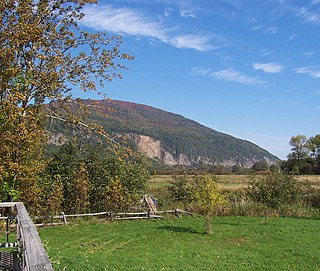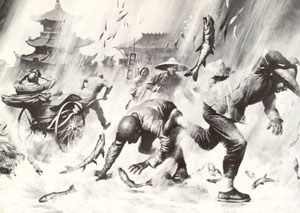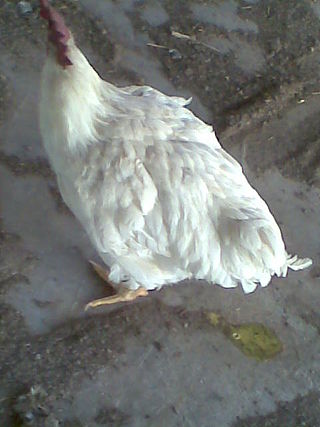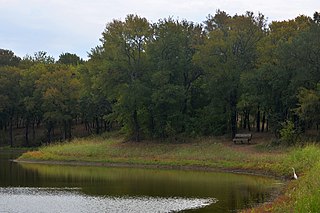Related Research Articles

Beebe is a city in White County, Arkansas, United States. The population was 7,315 at the 2010 U.S. Census, making it the second most populous in the county. The city is home to Arkansas State University-Beebe. ASU-Beebe also has branch campuses in Heber Springs and Searcy and at Little Rock Air Force Base.

The red-winged blackbird is a passerine bird of the family Icteridae found in most of North America and much of Central America. It breeds from Alaska and Newfoundland south to Florida, the Gulf of Mexico, Mexico, and Guatemala, with isolated populations in western El Salvador, northwestern Honduras, and northwestern Costa Rica. It may winter as far north as Pennsylvania and British Columbia, but northern populations are generally migratory, moving south to Mexico and the Southern United States. Claims have been made that it is the most abundant living land bird in North America, as bird-counting censuses of wintering red-winged blackbirds sometimes show that loose flocks can number in excess of a million birds per flock and the full number of breeding pairs across North and Central America may exceed 250 million in peak years. It also ranks among the best-studied wild bird species in the world. The red-winged blackbird is sexually dimorphic; the male is all black with a red shoulder and yellow wing bar, while the female is a nondescript dark brown. Seeds and insects make up the bulk of the red-winged blackbird's diet.

The Canada goose, sometimes called Canadian goose, is a large wild goose with a black head and neck, white cheeks, white under its chin, and a brown body. It is native to the arctic and temperate regions of North America, and it is occasionally found during migration across the Atlantic in northern Europe. It has been introduced to France, the United Kingdom, Ireland, Finland, Sweden, Denmark, New Zealand, Japan, Chile, Argentina, and the Falkland Islands. Like most geese, the Canada goose is primarily herbivorous and normally migratory; often found on or close to fresh water, the Canada goose is also common in brackish marshes, estuaries, and lagoons.

The Cap Tourmente National Wildlife Area is a National Wildlife Area (NWA) located on the north shore of the Saint Lawrence River in the National Provincial Capital Region of Quebec, established on 28 April 1978. It is one of the critical habitats for the greater snow goose during migration. Flocks of tens of thousands of these birds stop over to feed on the bullrushes in the spring and fall. The tidal marsh was recognized as a wetland of international significance per the Ramsar Convention in 1981, the first North American site to receive that distinction.

The common starling, also known as the European starling in North America and simply as the starling in Great Britain and Ireland, is a medium-sized passerine bird in the starling family, Sturnidae. It is about 20 cm (8 in) long and has glossy black plumage with a metallic sheen, which is speckled with white at some times of year. The legs are pink and the bill is black in winter and yellow in summer; young birds have browner plumage than the adults. It is a noisy bird, especially in communal roosts and other gregarious situations, with an unmusical but varied song. Its gift for mimicry has been noted in literature including the Mabinogion and the works of Pliny the Elder and William Shakespeare.

The whooping crane is an endangered crane species, native to North America, named for its “whooping” calls. Along with the sandhill crane, it is one of only two crane species native to North America, and it is also the tallest North American bird species. The whooping crane's lifespan is estimated to be 22-24 years in the wild. After being pushed to the brink of extinction, due to unregulated hunting and loss of habitat, and just 21 wild cranes remaining by 1941, conservation efforts would lead to a partial recovery. The total number of cranes in the surviving migratory population, plus three reintroduced flocks and in-captivity, only slightly exceeds 800 birds as of 2020.

A rain of animals is a rare meteorological phenomenon in which flightless animals fall from the sky. Such occurrences have been reported in many countries throughout history. One hypothesis is that tornadic waterspouts sometimes pick up creatures such as fish or frogs, and carry them for up to several miles. However, this aspect of the phenomenon has never been witnessed by scientists.

A bird strike is a collision between an airborne animal and a moving vehicle. The term is also used for bird deaths resulting from collisions with structures such as power lines, towers and wind turbines.

Robert Allen Fitzwilliam Gillmor MBE was a British ornithologist, artist, illustrator, author, and editor. He was a co-founder of the Society of Wildlife Artists (SWLA) and was its secretary, chairman and president. He contributed to over 100 books, and received numerous awards.

John Thomas Miner, OBE, or "Wild Goose Jack," was a Canadian conservationist called by some the "father" of North American conservationism.
The Tasman starling was described in 1836 by John Gould as a species which occurred on both Norfolk Island and Lord Howe Island. In 1928 Australian ornithologist Gregory Mathews recognized that the plumage of the race from Lord Howe Island was much browner and more greyish than the plumage of the Norfolk Island race and split the species into two forms, the Norfolk starling, and the Lord Howe starling. Both subspecies are now extinct, thus so the species.

The term fish kill, known also as fish die-off, refers to a localized die-off of fish populations which may also be associated with more generalized mortality of aquatic life. The most common cause is reduced oxygen in the water, which in turn may be due to factors such as drought, algae bloom, overpopulation, or a sustained increase in water temperature. Infectious diseases and parasites can also lead to fish kill. Toxicity is a real but far less common cause of fish kill.

Fowl cholera is also called avian cholera, avian pasteurellosis and avian hemorrhagic septicemia.
Overpopulation or overabundance is a phenomenon in which a species' population becomes larger than the carrying capacity of its environment. This may be caused by increased birth rates, lowered mortality rates, reduced predation or large scale migration, leading to an overabundant species and other animals in the ecosystem competing for food, space, and resources. The animals in an overpopulated area may then be forced to migrate to areas not typically inhabited, or die off without access to necessary resources.

Starlicide or gull toxicant is a chemical avicide that is highly toxic to European starlings and gulls, but less toxic to other birds or to mammals such as humans and pets.

Hagerman National Wildlife Refuge (HNWR), a haven for migratory birds and other wildlife, lies in northwestern Grayson County, Texas, on the Big Mineral Arm of Lake Texoma, on the Red River between Oklahoma and Texas. This National Wildlife Refuge is made up of water, marsh, and upland habitat. Visitors can hike, observe wildlife, hunt, and fish throughout the year.

The Summer Lake Wildlife Area is a 29.6-square-mile (77 km2) wildlife refuge located on the northwestern edge of the Great Basin drainage in south-central Oregon. It is administered by the Oregon Department of Fish and Wildlife. The refuge is an important stop for waterfowl traveling along the Pacific Flyway during their spring and fall migrations. The Summer Lake Wildlife Area also provides habitat for shorebirds and other bird species as well as wide variety of mammals and several fish species. The Ana River supplies the water for the refuge wetlands.
Lee Saunders Crandall was an American ornithologist and General Curator of Bronx Zoo. He worked at the Bronx Zoo from 1908 until his death in 1969.
The National Wildlife Health Center (NWHC) is a science center of the United States Geological Survey. NWHC is located in Madison, Wisconsin, on a 24-acre plot of land that includes a main building and tight isolation building (TIB). The facility houses Bio-safety Level 3 (BSL-3) and Bio-safety Level 2 (BSL-2) laboratories on site.
A mass mortality event (MME) is an incident that kills a vast number of individuals of a single species in a short period of time. The event may put a species at risk of extinction or upset an ecosystem. This is distinct from the mass die-off associated with short lived and synchronous emergent insect taxa which is a regular and non-catastrophic occurrence.
References
- ↑ "Birds Falling From the Sky Not Unusual". 6 January 2011.
- ↑ "SCIENCE NEWS Mass bird deaths rare, not apocalyptic: experts". 6 January 2011. Archived from the original on 11 July 2012. Retrieved 8 January 2011.
- ↑ "Black-bird die-off Investigation". Archived from the original on 14 January 2011. Retrieved 20 January 2011.
- ↑ "Group - Afanasiy Ilich Tobonov". Archived from the original on 23 July 2011. Retrieved 8 January 2011.
- ↑ "Rational help at hand when omens seem bad". The Standard. Archived from the original on 19 October 2012. Retrieved 11 September 2011.
- ↑ Epstein, Victor (27 January 2009). "Bird culling fallout alarms New Jersey community". AP Online. Archived from the original on 24 September 2015.
- ↑ "Dead birds in Franklin Township were killed on purpose". 26 January 2009.
But no humans or pets were ever at risk, said the USDA, contending the pesticide, known as DRC-1339, is inert once it is eaten by the birds and becomes metabolized.
- ↑ "More than 80 dead birds found in small Quebec town", Toronto Star, 7 January 2011, retrieved 8 January 2011
- ↑ Geese die during fireworks display Archived 2011-01-23 at the Wayback Machine , Rob O'Flanagan, Guelph Mercury, 4 January 2011
- ↑ Weise, Elizabeth (5 January 2011). "Fireworks likely cause of massive Ark. bird kill". USA Today . Retrieved 7 January 2011.
It was someone shooting off professional grade fireworks in a residential district, scaring the night-blind birds out of their roost into a 25-mph flight that ran them into houses, signs and even the ground, says Karen Rowe, Arkansas Game and Fish Commission ornithologist.
- ↑ Larkey, Nichole; AP (4 January 2011). "500 birds found dead in Louisiana". Labarre, Louisiana. Archived from the original on 7 January 2011. Retrieved 7 January 2011.
- ↑ Travis Walter Donovan (6 January 2015). "Birds Dying In Italy: Thousands Of Turtle Doves Fall Dead From Sky". The Huffington Post. Retrieved 7 January 2011.
- ↑ "Faenza: la pioggia delle tortore morte si colora di blu". GeaPress (in Italian). 5 January 2011. Archived from the original on 7 January 2011. Retrieved 7 January 2011.
- ↑ "Mysterious bird deaths hit Sweden". BBC News. 5 January 2011. Retrieved 7 January 2011.
- ↑ "Swedish bird mystery: Deaths due to 'external injuries'". BBC News. 6 January 2011. Retrieved 7 January 2011.
- ↑ Jetzt auch tote Vögel in Italien, Blick.ch, 8 January 2011
- ↑ Jackson, Emily (22 October 2011), "Thousands of dead birds wash ashore at Wasaga Beach", Toronto Star, retrieved 24 October 2011
- ↑ Melissa Block (15 December 2011). "Ornithologist Discusses Causes Of Bird Downings". NPR. Retrieved 16 January 2012.
- ↑ "Dead blackbirds fall again in Arkansas town". Boston Globe . AP. 31 December 2011. Retrieved 1 January 2012.
- ↑ "Hundreds of birds fall from sky in Draper". 30 January 2018. Retrieved 30 January 2018.
- ↑ Shaw, Amelia (11 December 2019). "Mystery as up to 300 dead birds fall out of the sky with organs spewing out". mirror. Retrieved 11 December 2019.
- ↑ "Nearly 1,000 migrating songbirds perish after crashing into windows at Chicago exhibition hall". AP News. 6 October 2023. Retrieved 6 October 2023.